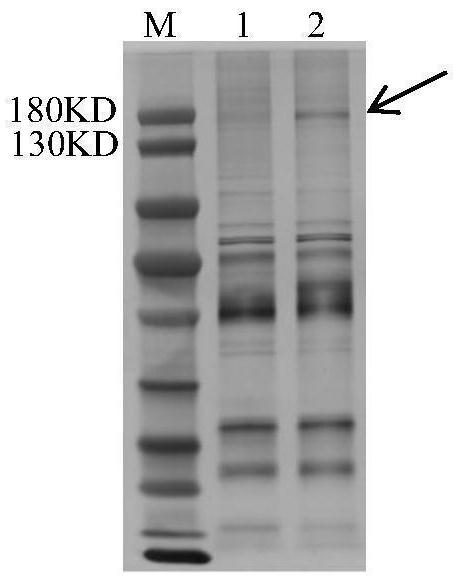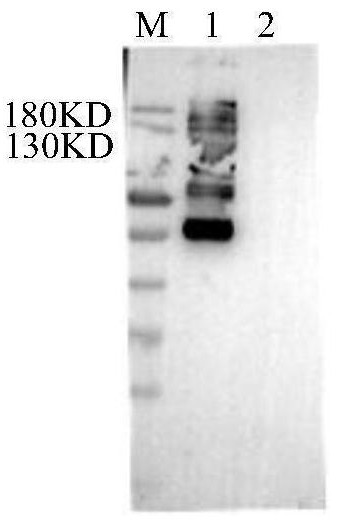Anti-Shroom2 autoantibody for detecting autoimmune system diseases as well as product and application thereof
An autoantibody, autoimmune technology, applied in the biological field, can solve the problems that have not yet been reported on Shroom2 autoantibodies
- Summary
- Abstract
- Description
- Claims
- Application Information
AI Technical Summary
Problems solved by technology
Method used
Image
Examples
Embodiment 1
[0050] Example 1: Immunofluorescence of rat primary neuronal cells
[0051] Step 1 Rat primary neuronal cell isolation
[0052] 1. Pregnant mice were anesthetized with 10% chloral hydrate, soaked in 75% alcohol for 3 minutes, and the fetal mice were taken out from the biological safety cabinet;
[0053] 2. Use pre-chilled HBSS (137mM NaCl, 5.4mM KCl, 0.6mM MgSO 4 ·7H 2 O, 0.5mM MgCl 2 ·6H 2 O, 0.3mM Na 2 HPO 4 ·2H 2 O, 0.4mM kH 2 PO 4, 5.6mM Grucose, 4.2mM NaHCO 3 , pH7.2~7.4) wash the fetal mouse twice, dissect out the fetal brain in pre-cooled HBSS and soak it in pre-cooled DMEM;
[0054] 3. Discard DMEM and cut the tissue block into 1m with ophthalmic scissors 3 size mixture. Papain was added (at a concentration of 2 mg / ml). Digest at 37°C for 30 minutes in a 10cm dish with gentle shaking every 5 minutes. Generally 20ml of digestive juice for 10 to 15 brain tissues;
[0055] 4. After digestion, transfer the cells to a 50ml centrifuge tube, add 20ml DMEM to re...
Embodiment 2
[0082] Example 2: Immunoprecipitation of shroom2
[0083] 1. Take 6 dishes of rat primary neuron cells, discard the supernatant, wash twice with PBS, fix with 0.4% paraformaldehyde for 10 min, and wash three times with 1× HEPES;
[0084] 2. Serum incubation: Take 10ul of patient 1 serum and add it to 10ml of DMEM (1:1000 dilution), filter it with a 0.22um filter, add it to the fixed cells, and incubate at room temperature for 2h;
[0085] 3. Add 15ul beads to a 2mL tube, wash 3 times with equilibration solution, and seal with 300ul 4% BSA for 2h;
[0086] 4. Put the incubated cells on ice, discard the supernatant, wash twice with PBS, add 500ul lysis buffer (150mM NaCl, 1mM EDTA, 100mM Tris-HCl, 0.5% sodium deoxycholate, 1% TritonX-100, 0.1% SDS, pH 7.5), collect cells, add protease inhibitor with a final concentration of 1×, lyse for 30 min, shake at intervals, centrifuge at 15,000 rpm for 30 min, take the supernatant, and measure the concentration;
[0087] 5. Add the supe...
Embodiment 3
[0093] Example 3: Immunoblotting
[0094] 1. Electrophoresis: take the sample obtained in step 7 of Example 2 for SDS-PAGE;
[0095] 2. Transfer membrane: after electrophoresis is completed, use wet method to transfer membrane, and the transfer condition is 200mA, 90min;
[0096] 3. Blocking: Block with 5% skimmed milk powder at room temperature for 1 hour;
[0097] 4. Primary antibody incubation: incubate anti-shroom2 polyclonal antibody (antibody purchased from sigma) at a ratio of 1:2000, and incubate at room temperature for 2 hours;
[0098] 5. Washing: TBST wash 3 times, 5min each time;
[0099] 6. Secondary antibody incubation: add HRP-labeled secondary antibody and incubate at room temperature for 1h
[0100] 7. Washing: TBST wash 3 times, 5min each time;
[0101] 8. Color development: add chemiluminescent solution and record the results.
[0102] Experimental results:
[0103] Western blot analysis of immunoprecipitates received with patient 1 serum, but not with...
PUM
 Login to View More
Login to View More Abstract
Description
Claims
Application Information
 Login to View More
Login to View More - R&D
- Intellectual Property
- Life Sciences
- Materials
- Tech Scout
- Unparalleled Data Quality
- Higher Quality Content
- 60% Fewer Hallucinations
Browse by: Latest US Patents, China's latest patents, Technical Efficacy Thesaurus, Application Domain, Technology Topic, Popular Technical Reports.
© 2025 PatSnap. All rights reserved.Legal|Privacy policy|Modern Slavery Act Transparency Statement|Sitemap|About US| Contact US: help@patsnap.com



